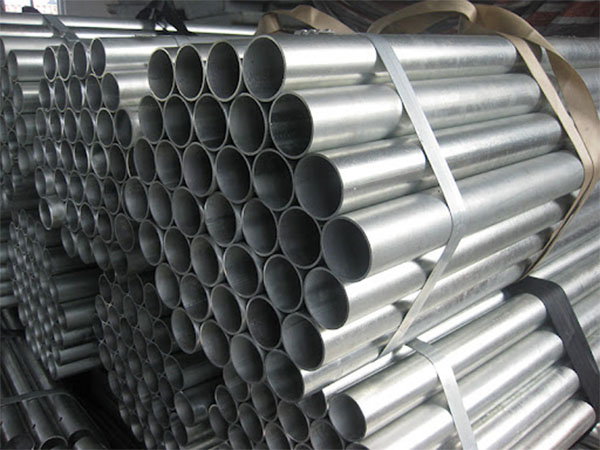Galvanized carbon steel pipe is a type of steel pipe that uses ordinary carbon steel pipe as the base material and is coated with a layer of zinc on its surface to form a physical and chemical barrier, thereby significantly enhancing the pipe's corrosion resistance and service life.
Galvanizing process is a common anti-corrosion treatment process for steel pipes. Galvanized steel pipes are generally used in various pipeline systems such as water supply, gas transmission, petroleum and chemical industries.

The main methods of galvanizing
Hot-dip galvanizing: Hot-dip galvanizing involves immersing pre-treated carbon steel pipes into molten zinc at around 600℃, causing a metallurgical reaction between zinc and the surface of the steel pipes to form a composite coating composed of a zinc-rich layer and a zinc-iron alloy layer.
Hot-dip galvanizing features thick coating, strong adhesion and excellent weather resistance. Common process methods include wet method, dry method, oxidation-reduction method, etc. Among them, dry method and oxidation-reduction method have become mainstream due to their better surface activation effects.
Electro-galvanizing: Electro-galvanizing is a process in which carbon steel pipes are used as the cathode in an electrolyte containing zinc ions, and a uniform metallic zinc layer is generated through electrolysis. The coating is relatively thin and is typically applied in situations where precise dimensions and coating thickness are required.
The electro-galvanizing method is suitable for applications with thin-walled tubes, single-sided coatings, or requirements for thickness differences between inner and outer layers (such as precision instrument pipes), and its zinc consumption is 60%-75% lower than that of hot-dip galvanizing
Characteristics and Performance
Anti-corrosion performance:
The galvanized coating can effectively isolate moisture and oxygen, form a firm bond with the steel substrate, and protect the base material through sacrificial anodes, significantly delaying the oxidation and corrosion processes. In outdoor and suburban environments, the standard coating can last for more than 50 years without maintenance. It can last for more than 20 years in urban or coastal environments. In addition, galvanized carbon steel pipes also have a high resistance to physical damage. The coating is tough and not easy to peel off.
Mechanical properties:
Due to the high strength, good weldability and pressure resistance of the carbon steel pipe base itself, galvanized steel pipes also have stable structural load-bearing capacity and are suitable for high-pressure and heavy-load working conditions
Common standards and specifications
ASTM A53: Covering seamless and welded carbon steel tubes, including black tubes and hot-dip galvanized tubes, with nominal dimensions ranging from 1/8 to 26 inches.
ASTM A123: General Coating Specification for Hot-dip Galvanized Steel Products.
ASTM A153: Specification for electro-galvanizing of fasteners, but its concept is also applicable to small carbon steel pipe fittings.
ASTM A106: High-temperature service standard for Seamless Carbon steel tubes, some of which can also undergo hot-dip galvanizing.
ASTM A501: Hot-formed welded and seamless carbon steel structural tubes, including hot-dip galvanized square, round, rectangular and special profiles.
The limitations of galvanizing carbon steel pipes
Temperature limit: Zinc may volatilize and release harmful gases above 200° C. Caution should be exercised in high-temperature scenarios.
Coating damage risk: If the zinc layer is damaged, the carbon steel substrate may accelerate corrosion due to electrochemical reactions. Therefore, galvanized steel pipes should be inspected and maintained regularly during use.
The packaging method of galvanized seamless pipes
Small outer diameter: Bound with hexagonal steel straps
Large outer diameter: Bulk
Packed in waterproof plastic woven bags
Packed in wooden cases
Customized according to customer requirements
Main application fields
Construction: It is used for handrails, railings, stairs, door and window frames, as well as indoor water supply and gas pipelines.
Municipal water supply and drainage: Urban water supply pipelines, connecting pipes for water treatment equipment, etc.
Petrochemical and chemical engineering: Pipelines used for transporting corrosive media in chemical plants to extend the service life of equipment.
Natural gas transportation: Gas pipelines that meet high safety requirements.
Outdoor facilities: Protective steel components such as guardrails, fences, landscape components and escalators.
Product maintenance and safety precautions
Regular inspection: If the coating is found to be damaged, it should be repaired in time (such as by spraying zinc paint).
Welding protection: Avoid inhaling zinc fumes during welding. Ensure good ventilation or use protective equipment.
Environmental adaptation: In environments with strong acids or strong alkalis, it is recommended to switch to stainless steel or specially coated pipes.
Summary
Galvanized carbon steel pipes achieve excellent anti-corrosion performance and reliable mechanical load-bearing capacity by forming a dense and durable zinc coating on the surface of carbon steel. It complies with multiple international standards and features both cost-effectiveness and ease of inspection. Therefore, it has been widely applied in fields such as construction, municipal works, petrochemicals, natural gas, and outdoor facilities.
